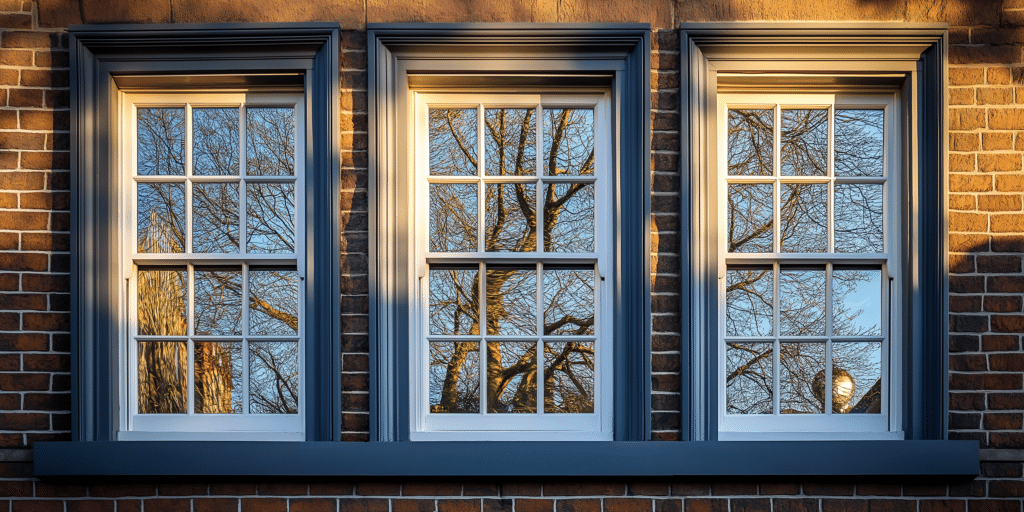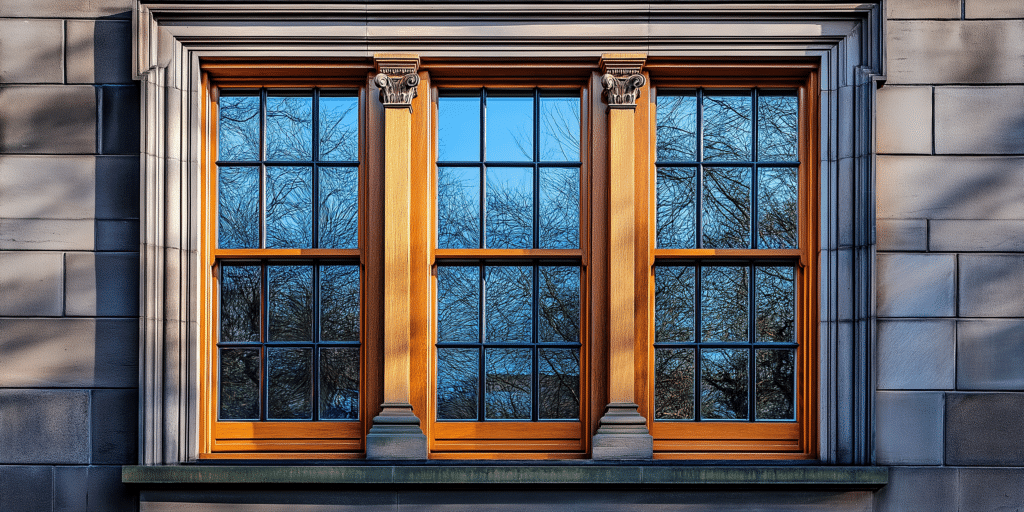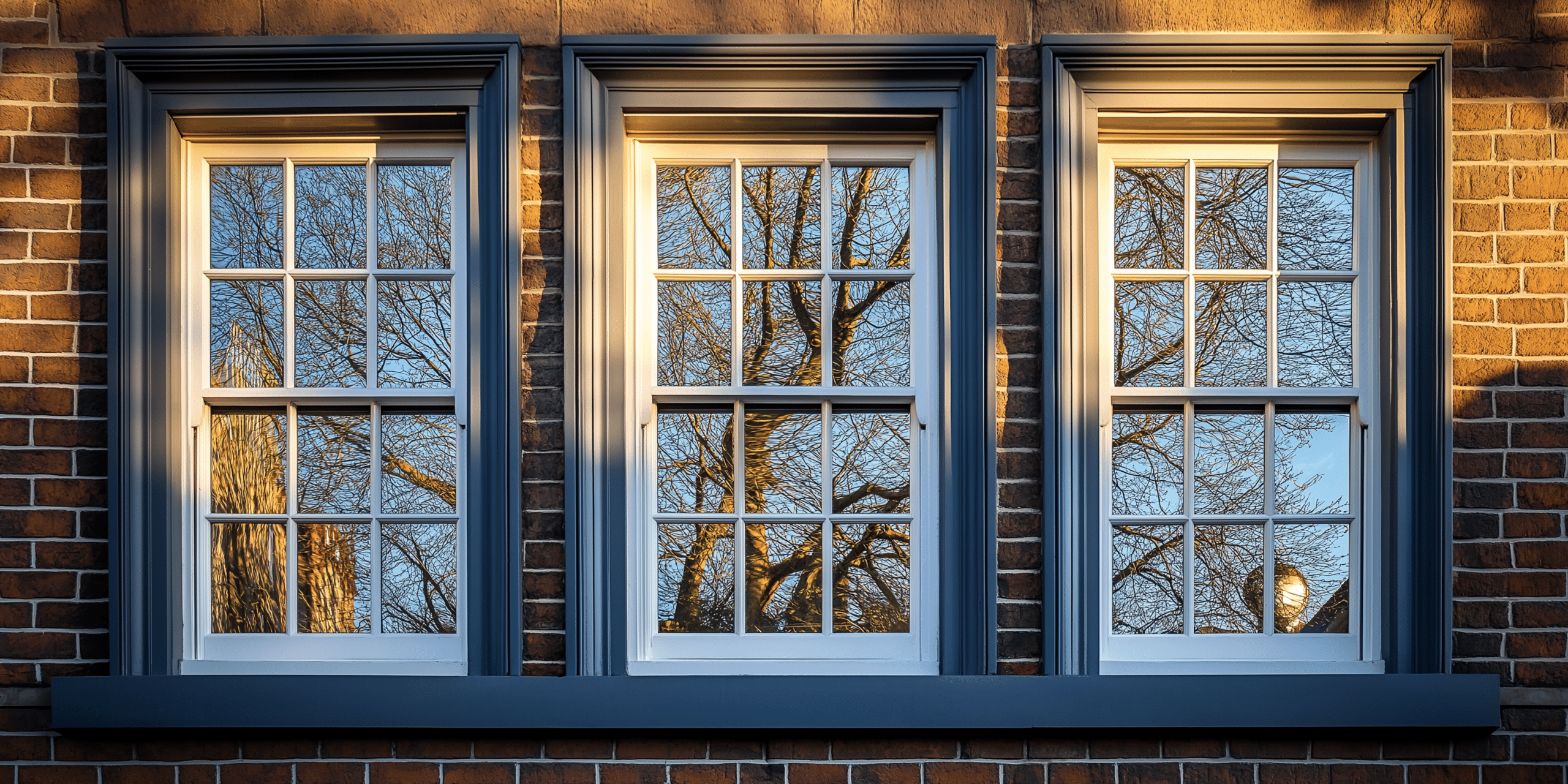Choosing the right sash window colour can transform a property’s appeal and significantly impact its value. Let’s explore expert tips to help you make a lasting colour choice that complements both modern and traditional aesthetics.
Get a head start on your next home improvement project by exploring our colour selection service.
Why Colour Matters for Sash Windows
Choosing the right colour for your sash windows can greatly influence your home’s appearance, architectural harmony, and overall market appeal. With well-coordinated exterior colours, homeowners can see a potential value increase of up to 10%. Additionally, 94% of estate agents report that curb appeal, largely shaped by window colour, plays a key role in attracting buyers.
Enhancing Traditional vs. Modern Styles
When it comes to traditional homes, deeper hues—such as heritage greens or rich navy—often emphasise classic architectural lines, adding a timeless feel. In contrast, lighter, neutral shades like soft grey or cream complement modern sash windows, lending a sleek, minimalist vibe.
Colour Psychology in Sash Windows
The psychological impact of colours cannot be underestimated. For instance:
- Warm tones (e.g., red or mustard) can evoke warmth and energy, ideal for cottages.
- Cool tones (like green or blue) often provide a calming effect, suiting suburban homes or rural properties.
Common Mistakes in Window Colour Selection
To avoid missteps, choose colours that harmonise with your home’s architectural period. A mismatch can detract from your home’s character; for instance, bright contemporary colours on a Victorian property might clash with its historical appeal.
Urban vs. Rural Colour Trends
Urban homes often benefit from darker, bolder shades for a sophisticated look, while rural homes lean towards lighter, earthy tones to blend naturally with the landscape. Balancing trends with timeless appeal ensures your choice remains attractive to future buyers.
Tip 1: Consider Your Home’s Exterior Style and Era

Selecting a sash window colour that complements your home’s architectural period enhances authenticity and boosts curb appeal. Using period-appropriate colours, such as those seen on Georgian, Victorian, or Edwardian homes, can increase your property’s allure—82% of heritage buyers find historically accurate colours highly appealing.
Matching Colours to Iconic Architectural Styles
For Georgian homes, white or off-white sash windows highlight the symmetrical, classic design. Victorian properties, on the other hand, often suit deep green or black shades, creating contrast with intricate brickwork and trim details. Edwardian homes typically use soft, neutral tones, aligning with their spacious, elegant aesthetic.
Balancing Modern Colours with Historic Integrity
If your aim is to modernise a historical property while retaining its charm, consider muted or earthy colours that harmonise with the original design. Contemporary shades, like slate grey, can add sophistication without compromising authenticity.
Tips for Listed Buildings
For listed properties, check for local restrictions on exterior colours to ensure compliance. Many heritage councils recommend using approved heritage colours, which not only respect the property’s history but also align with community standards.
By choosing a colour that resonates with your home’s architectural style, you can achieve a look that feels both timeless and market-friendly—76% of homeowners report that matching window colours to architecture enhances overall aesthetic appeal.
Tip 2: Balance with Exterior Elements
Creating a cohesive colour scheme for your sash windows involves coordinating them with key exterior elements, like doors, trims, and landscaping. This approach not only enhances your home’s aesthetic but also brings a polished, harmonious look that impresses potential buyers.
Coordinating Colours for Harmony
Aligning window colours with doors and trims is an effective way to unify your home’s appearance. For instance:
- Matching Windows and Doors: Choosing a similar or complementary colour for windows and doors creates a seamless look. If your front door is a bold shade, consider using a more neutral window colour to balance the effect.
- Contrasting Trims: A contrasting trim colour can highlight architectural details. Light-coloured trims, paired with darker sash windows, provide a timeless look, especially for traditional homes.
Considering Material and Natural Surroundings
For a balanced design, take note of your home’s building materials. 70% of architects recommend window colours that complement materials like stone or brick. Additionally, consider landscaping elements—earthy window tones, like olive or deep green, blend well with lush surroundings, while cool grey hues can harmonise with modern, minimalist exteriors.
A cohesive exterior colour scheme isn’t just visually appealing—it’s a smart choice. 65% of design experts agree that aligning colours with exterior elements enhances your home’s overall impression, giving it a refined and cohesive look.
Tip 3: Choose Colours That Work with Natural Lighting
Natural lighting can transform the way colours appear on your sash windows, influencing both the depth and intensity of shades throughout the day. Since 60% of homeowners notice significant colour shifts in varying light conditions, testing window colours under multiple lighting scenarios is essential to ensure your chosen hue complements your home at all times.
Understand How Lighting Impacts Colour Perception
Morning sunlight, which is cooler and softer, often makes colours appear slightly muted. In contrast, afternoon light, which is warmer and more direct, can make shades look richer and more intense. For example, deep blues or greens might appear more vibrant in the afternoon, while lighter neutrals may shine in the morning light.
Tips for Selecting Colours Based on Lighting
- Test Colours at Different Times of Day: Since 55% of interior designers recommend this approach, applying paint samples on your window frame and observing them from morning to evening can reveal how each colour adapts.
- Consider Shaded Areas: In shaded spots or areas with indirect sunlight, opt for lighter shades that reflect light, preventing a dull or washed-out look.
- Choose Vibrant Colours in Bright Light: For well-lit exteriors, deeper, saturated colours often hold their vibrancy, creating a dynamic visual effect.
Harmonising sash window colours with natural light elevates your home’s exterior, giving it a dynamic look that feels inviting, balanced, and timeless.
Tip 4: Use Complementary and Contrasting Shades

Adding complementary or contrasting colours to your sash windows can enhance your home’s architectural detail and create a balanced, yet distinctive appearance. 68% of colour consultants recommend using complementary shades to bring out key design features, while 72% of design professionals rely on the colour wheel to build cohesive, harmonious exteriors.
The Power of Colour Contrast
Contrasting colours, such as pairing a deep blue sash with white trim, can make windows pop while adding dimension to your façade. When done right, complementary colours highlight specific areas, such as window frames or accents, without overpowering the overall design. This method is particularly effective on classic architectural styles, where boldness meets balance.
Popular Complementary Colour Pairs for Sash Windows
- Navy and Ivory: Timeless, crisp contrast, ideal for modern or classic styles.
- Olive Green and Cream: Natural and subtle, perfect for rustic or traditional homes.
- Slate Grey and Soft Yellow: Adds a gentle contrast, enhancing warmth in shaded areas.
Tips for a Balanced Colour Scheme
- Avoid Colour Clashes: Stick with a maximum of two main colours to prevent overwhelming your exterior.
- Consider Building Materials: Select colours that complement your home’s materials, be it brick, stone, or timber, for a polished, cohesive look.
Using complementary shades effectively can not only boost curb appeal but also ensure that your home stands out in a tasteful and balanced way.
Tip 5: Test with Samples Before Committing
When it comes to selecting the perfect sash window colour, taking the time to test samples is essential. According to 58% of homeowners, skipping this step led to regret over their final choice. Testing colours not only provides a clearer sense of how they’ll look on your window frames but also helps avoid costly repainting or refinishing.
Best Practices for Colour Testing
To ensure your chosen colour harmonises with your home’s exterior:
- Use Sample Boards or Swatches: Apply sample boards or paint swatches to different parts of your window frames. This allows you to observe how the colour looks under varied lighting and weather conditions.
- Test Under Natural Light: Apply samples in different areas around your home to view them under both shaded and direct sunlight. Morning and afternoon light can significantly impact the hue, so try viewing samples at different times of day.
Common Mistakes to Avoid
Many people make the mistake of testing only on one small section. Instead, cover multiple areas to gauge how the colour interacts with surrounding elements. 80% of painting professionals recommend this approach for better satisfaction with the end result.
Sample testing may seem like an extra step, but it’s a proven way to ensure you’re fully confident in your final colour choice.
Tip 6: Consider the Long-Term Maintenance of Your Chosen Colour
Choosing a sash window colour is about more than just aesthetics; understanding the maintenance required can help ensure lasting appeal. Darker colours, for instance, often need touch-ups sooner due to fading, with up to 20% faster fading in direct sunlight compared to lighter tones. This translates to more frequent maintenance—usually every 3-5 years for darker shades, while lighter colours can go up to 5-7 years before needing a fresh coat.
Key Tips for Longevity
- Consider UV-Protective Coatings: UV coatings can significantly slow down fading, especially for sun-exposed areas. This extra layer of protection is particularly helpful if you’ve chosen a dark colour.
- Regular Cleaning and Touch-Ups: Light, regular cleaning helps prevent dirt buildup that can dull the appearance. Use mild cleaners and avoid harsh chemicals to maintain the paint’s integrity.
- Select Colours with Low Maintenance in Mind: Light greys, off-whites, and neutrals often show less wear over time. They’re easier to maintain and typically require fewer touch-ups than bold, dark colours.
Colour-Specific Maintenance Needs
For those committed to darker colours, plan for regular touch-ups to maintain depth and vibrancy. 80% of painting professionals agree that testing colours in various lighting and using UV coatings can maximise lifespan.
Professional Advice on Choosing Sash Window Colours

When it comes to selecting the right sash window colour, consulting a professional can make a significant difference. With 70% of homeowners who sought expert advice reporting greater satisfaction, it’s clear that professionals offer valuable insights into architectural harmony, trend alignment, and practical longevity.
Why Professional Guidance Matters
- Enhanced Aesthetic: Colour specialists can help achieve a balanced look by choosing shades that enhance the architectural style, whether it’s Victorian, Edwardian, or modern. Their expertise ensures that colours complement, rather than clash with, your home’s existing elements.
- Reducing Repainting Costs: By recommending durable hues and finishes, professionals can reduce the likelihood of costly repaints, saving homeowners up to 15% in long-term maintenance.
- Trend-Driven Choices: Experts stay updated on colour trends, enabling them to suggest modern hues that retain classic appeal, keeping your home current yet timeless.
Key Tips from the Pros
To find the right consultant, look for experience with historic and contemporary properties alike. They’ll consider the home’s age, environment, and exposure to sunlight to ensure that your choice stays beautiful for years to come.
Matching Sash Window Colours with Interior Décor
Creating a seamless flow between your sash window colours and interior décor can elevate the aesthetic appeal of your home. 80% of interior designers recommend harmonising these elements for visual unity, and homes with well-coordinated interior and exterior colours can boost perceived value by up to 12%.
Why Colour Coordination Matters
Matching or contrasting sash window colours with your interior palette provides cohesion throughout your space. Whether you choose to reflect your wall colours or opt for a gentle contrast, colour harmony ensures a balanced, inviting look that connects each room with the exterior view.
- Complementing Interior Themes: If your home has a modern or traditional theme, choose window colours that complement key elements like furnishings and wall tones. Light, neutral window frames can work wonders in minimalist interiors, while rich, dark frames often suit period or eclectic décor.
- Creating Colour Flow: To achieve flow, consider picking a hue from your interior design to repeat in your window frame. This subtle repetition reinforces unity across spaces and makes rooms feel naturally connected to the exterior.
Practical Tips
- Contrast or Match: Light frames create a fresh contrast with dark walls, while dark frames add depth against lighter walls.
- Durability: Select colours that work in both interior and exterior settings, using finishes that resist fading to maintain harmony over time.
Common Mistakes to Avoid When Choosing Sash Window Colours
Selecting the perfect sash window colour can be challenging, with a few common pitfalls that often lead to regret. 60% of homeowners wish they’d avoided trendy shades that didn’t last, while 75% of real estate experts advise against overly bold colours for a timeless curb appeal. Here’s how to avoid some of the most frequent errors.
Mistake #1: Falling for Trendy Colours
Trendy colours might feel exciting but can quickly become outdated. Stick with classic shades that harmonise with your home’s style to ensure longevity and minimise the need for frequent repaints.
Mistake #2: Ignoring Natural vs. Artificial Lighting
Colours can look vastly different under varying light sources. To avoid surprises, test potential colours in natural light during different times of the day. This helps prevent clashes and ensures a cohesive look under all lighting conditions.
Mistake #3: Overlooking Climate Impact on Colours
In regions with intense sunlight, colours can fade faster. Consider UV-resistant finishes or choose lighter shades that naturally reflect light, prolonging your window colour’s lifespan.
Mistake #4: Mismatched Colours with Home Style
Certain colours don’t blend well with specific architectural styles. Traditional homes often look best with subdued, classic tones, while modern homes can handle bolder colours. Always consider your home’s design before settling on a colour.
Schedule Your Free Colour Consultation Today!

Choosing the right sash window colour can transform your home’s aesthetic and add long-lasting value. Ready to make the best choice with professional guidance? 85% of our clients report greater satisfaction with their colour selection after a consultation, while 92% feel more confident in their final decision.
Why Book a Colour Consultation?
Our free consultation gives you access to expert insights tailored to your unique style and home architecture. A professional colour advisor can help:
- Match colours seamlessly with your interior and exterior decor for a cohesive look.
- Avoid costly repainting by selecting a colour that maintains its vibrancy over time.
- Explore long-lasting and timeless colour options that align with your design goals.
What to Expect from Your Consultation
Booking a consultation is straightforward, free of charge, and obligation-free. During your session, our experts will:
- Assess your preferences and provide personalised colour recommendations.
- Answer questions on colour maintenance, regional climate effects, and trend longevity.
- Offer exclusive incentives for booking today, including limited-time discounts on selected services.
Frequently Asked Questions
What are the best sash window colours for different architectural styles?
For a timeless look, period-appropriate colours are ideal. Georgian and Victorian homes commonly feature white, cream, and heritage greens, as these shades maintain historical accuracy. Interestingly, 82% of heritage homebuyers prefer these authentic colours, adding a sense of charm and value to older properties.
Are there any colour restrictions for sash windows in conservation areas?
Yes, conservation areas often have guidelines to ensure that window colours align with local aesthetics. Many councils recommend heritage colour palettes to preserve character, with 74% advocating for these traditional shades to maintain uniformity and visual appeal.
What colours are most resistant to fading in high-sunlight areas?
In sunny regions, neutral shades like grey and beige are less prone to fading. For enhanced durability, UV-resistant paints can extend colour longevity by up to 25%, reducing the impact of direct sunlight.
Is it possible to change the colour of uPVC sash windows?
Yes, with specialist paints and coatings, you can refresh the colour of uPVC sash windows. 65% of homeowners who opted to change their uPVC window colours report that professional painting services deliver the most long-lasting results.
What should I consider when selecting a sash window colour to improve resale value?
To maximise resale appeal, consider neutral, classic colours such as white and off-white. Homes with well-coordinated exterior colours can see a value increase of up to 10%, according to real estate experts, enhancing their market attractiveness.
How can I maintain the colour on my sash windows to keep them looking fresh?
Regular maintenance, including cleaning and periodic repainting, keeps sash windows vibrant. Adding a UV-resistant coating can further extend colour life, reducing fading and keeping your windows looking fresh for up to five additional years.







